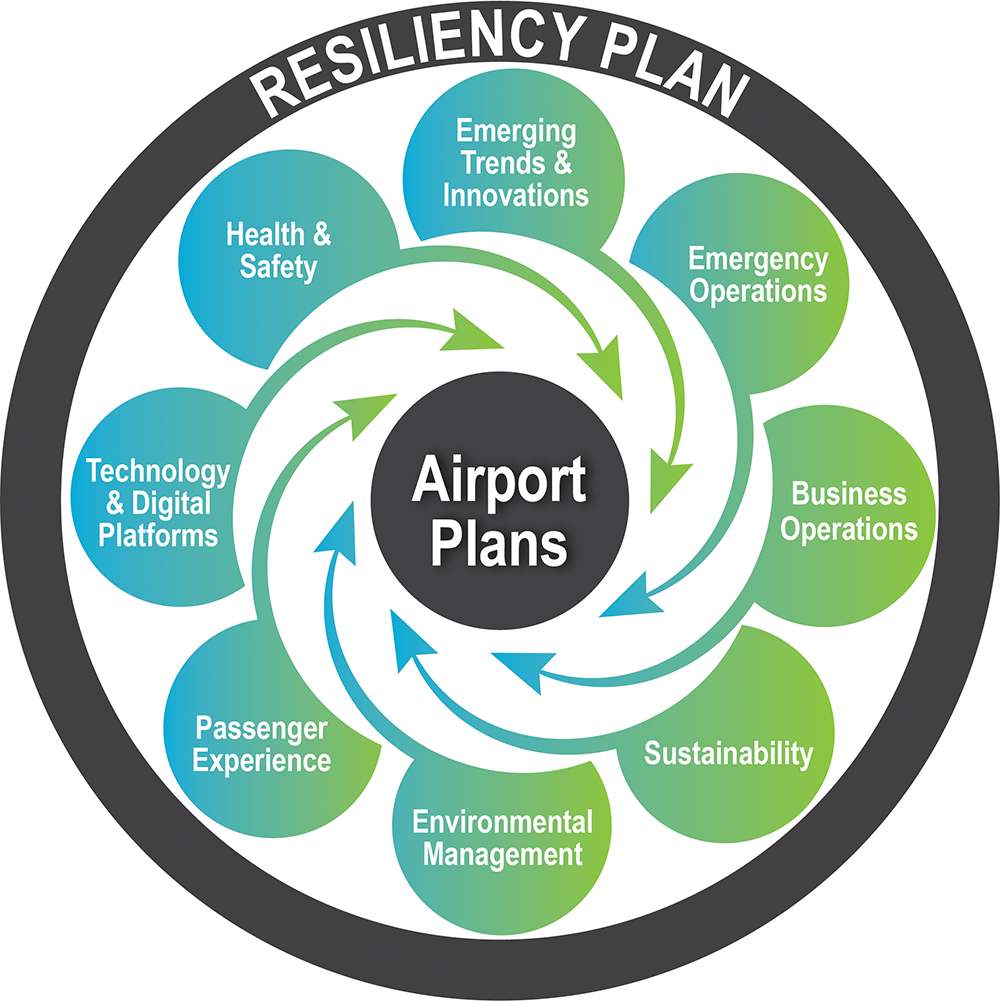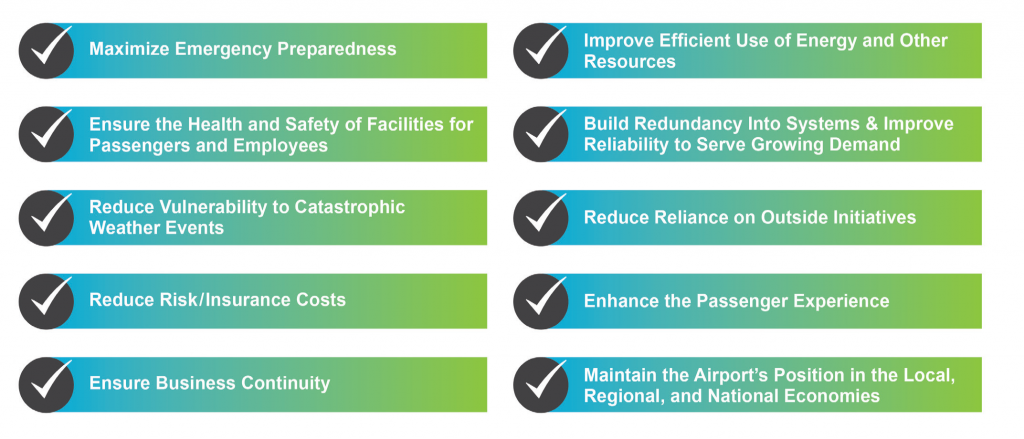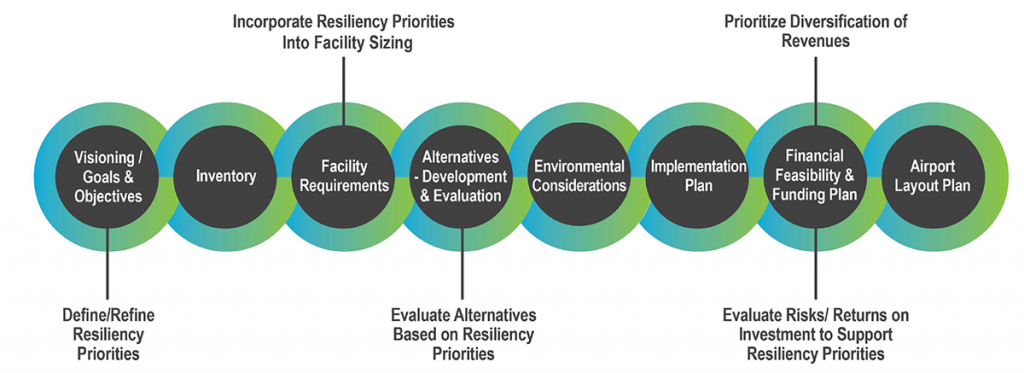Resiliency planning is often defined as assessing an airport’s risk for an extreme weather event and/or a catastrophic shift from current conditions due to climate change, and immediately preparing a plan to meet the demands of your passengers, tenants, and community at large in the face of an emergency. Although climate change and extreme weather are essential elements to consider in planning, they are not the only states of emergency that an airport could face. Resiliency planning is commonly thought of as an extension to sustainability planning, which strives to achieve a balance of environmental, operational, financial, and social responsibility goals. While sustainability planning is part of resiliency planning, the two are not interchangeable. When these common limits on resiliency planning are removed and the goal is expanded to increasing efficiency of all aspects of airport operations, it becomes clear just how comprehensive airport resiliency planning can be.
A resilient system can rebound quickly from shock or stress, particularly during unforeseen situations and conditions. Aviation has experienced immediate and significant effects from every major worldwide incident, pandemic, or recession including just a few major examples:
- Pilot strikes
- Air traffic control (ATC) strikes
- Fuel crises
- Energy crises
- Events and aftermath of September 11, 2001
- The Great Recession
- COVID-19 and other medical crises
The aviation industry will face new shocks in the future, both known and unknown. However, as history shows, once the event passes, the system will recover.
As airports plan for inevitable system recovery and the return of growth, priorities should include the establishment of a resiliency plan that unites all airport plans and operational programs, and ultimately reduces vulnerability to future system shocks. A resilient airport is one that can provide reassurance to stakeholders and passengers that it is prepared for rapid and dynamic change.
A Modern Approach to Airport Resiliency Planning
An airport resiliency plan establishes a process for an airport to evaluate and prioritize resiliency measures to ensure preparedness for any type of rapidly changing condition – while still operating efficiently and safely and supporting an airport’s critical role in the local and regional economies.
The two major elements of an airport resiliency plan include a current conditions assessment and a future risk projection. Risk assessment modeling is used to identify and measure risk associated with both “known events likely to occur” and “unknown events unlikely to occur.” Contingency plans are developed for both types of events.
The development of an airport resiliency plan begins with the assessment of an airport’s relative strengths and weaknesses and identifies areas of focus to improve the airport’s overall resilience.
The goal is to develop efficiency in all aspects of daily operations and future planning, as well as achieve open communication among all airport departments and stakeholders.
An airport resiliency plan unites all airport plans and operational programs, including, but not limited to the following:
- Master Plan
- Health & Safety
- Emergency Operations
- Business Operations
- Sustainability
- Environmental Management
- Passenger Experience
- Technology & Digital Platforms
- Emerging Trends & Innovations

The full force of airport resiliency planning is a unique opportunity to unite all airport plans and operational programs, resulting in many benefits, including:

Integration with Airport Planning
An airport resiliency plan does not replace existing planning efforts. Instead, it can be used to help inform critical planning efforts. Airport plans should strive to be resilient, adaptable, and flexible so airports can respond to unexpected events in a responsible manner.
In these cases, the planning efforts’ goals and objectives process can be used to identify the airport’s resiliency priorities.
If an airport has a resiliency plan, the priorities identified in the plan inform the planning study’s goals and objectives. However, many airports will not necessarily have resiliency plans in place before starting a planning effort. In these cases, the goals and objectives process can be used to identify the airport’s resiliency priorities.
The graphic below illustrates how resiliency planning can be incorporated into master planning efforts:

In the case of airport master plans and other planning studies, resiliency priorities can inform the calculation of facility requirements, as well as the development and evaluation of alternatives, ensuring that an airport moves forward on a strategic path that is both flexible and adaptable to future conditions.
Additionally, airports should consider growth and diversification of non-airline revenues essential to resiliency efforts and a balanced airport income statement. Resiliency also includes the concept of “futureproofing,” which assures that plans can adapt to changes in technology, regulations, and processes.
Examples of how resiliency priorities can inform planning efforts include the following:
Condition assessments to provide a better understanding of an airport’s assets during planning to properly align the need for retrofit or replacement and help avoid issues when a crisis arises.
Terminal space requirements for passenger and employee social-distancing, medical testing in international arrivals processing areas, and safe isolation of sick passengers, if needed.
Flexible planning solutions with proper zoning and adjacencies of program elements so spaces can be quickly altered or converted to other uses in a crisis.
Infrastructure requirements for emerging technologies both landside and airside, such as seamless passenger technologies from curb-to-gate and increased use of electric vehicles, autonomous vehicles, electric and/or vertical takeoff and landing (VTOL) aircraft.
Facility requirements that take into account climate change such as the need to improve stormwater systems due to increased flooding and/or the potential need for longer runway lengths due to rising temperatures.
Land use planning with an emphasis on increasing non-aeronautical revenues, particularly with land that does not have aeronautical uses.1
Financial planning that emphasizes the growth and diversification of all revenue sources.
The need for an airport to support urban resilience by aligning with regional, metropolitan, or city resiliency plans and helping to achieve those goals and objectives.
Regardless of an airport’s specific priorities, resiliency planning is most successful when it is fully integrated into all aspects of airport planning, development projects, and operational activities.
Summary
As gateways to our cities and regions, airports are often exposed to global, regional, and local challenges and must effectively and efficiently respond to them. With airport resiliency planning, airports can continue to lead the way toward preparing our communities for rapidly changing conditions and providing innovation during recovery from those conditions.
Airports today need solid plans to recover from system shocks, along with continued strategies to sustain growth.
Airport resiliency planning ensures preparedness for future ever-changing conditions and disruptive events, while still safely and efficiently operating the airport. The overall ability for dynamic response to change provides assurance to passengers, tenants, and stakeholders that the airport is prepared to face rapidly changing conditions and might even emerge stronger than before.
What is the L&B LAB?
The LAB is Landrum & Brown’s research and development unit. Our mission is to harness decades worth of industry knowledge and expertise to develop innovative solutions that support our clients along with promoting industry thought leadership.
This document was prepared by Landrum & Brown, Inc. | [email protected]
Sign up to receive our next L&B LAB in your inbox!
